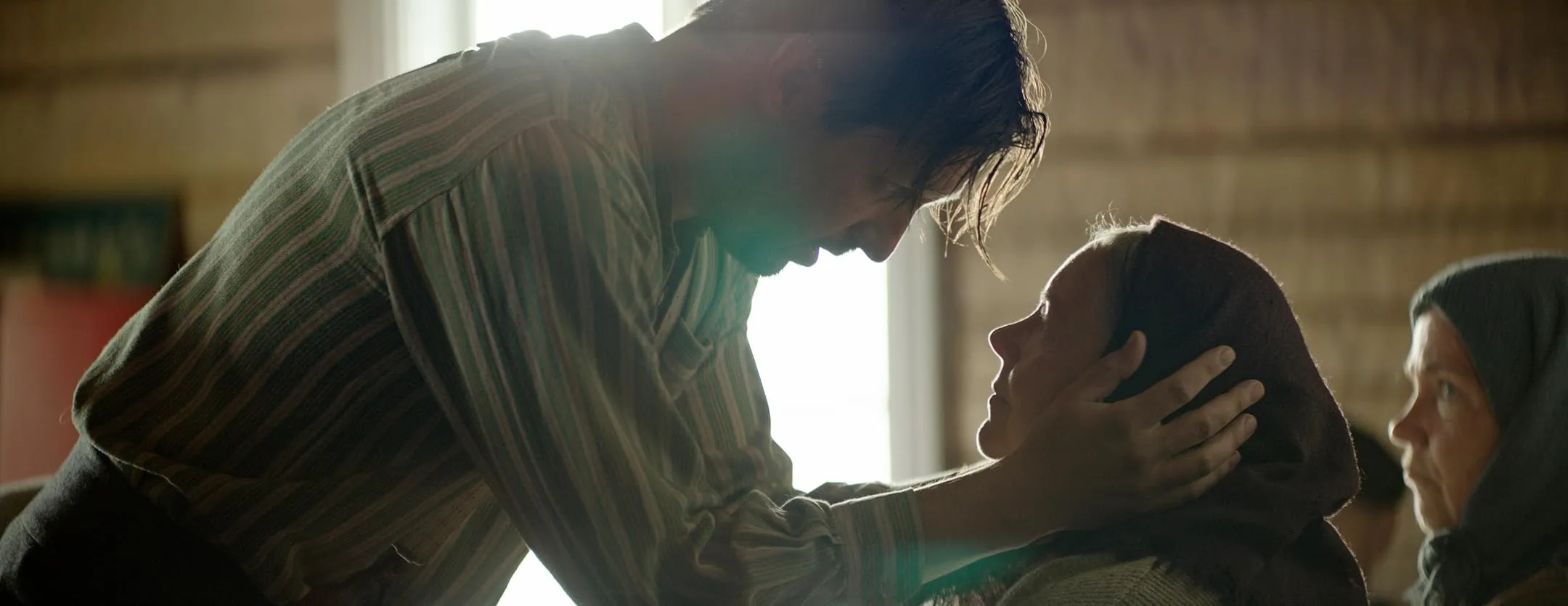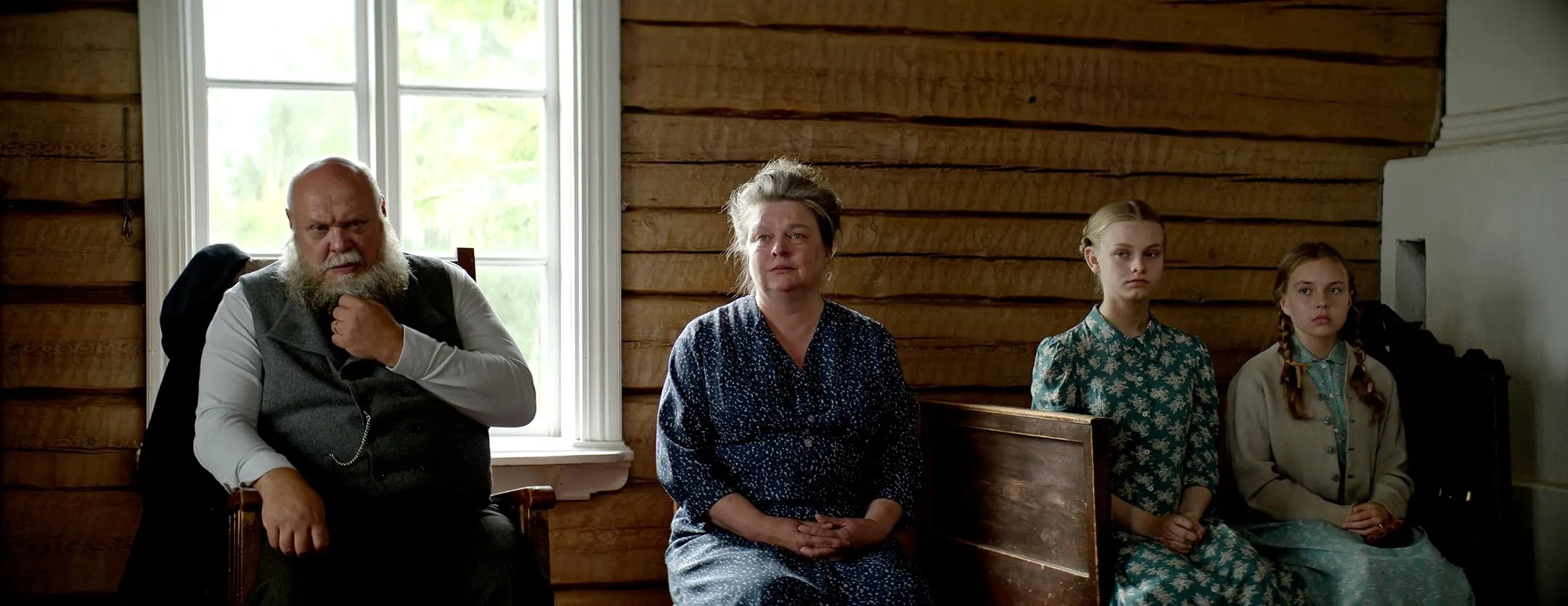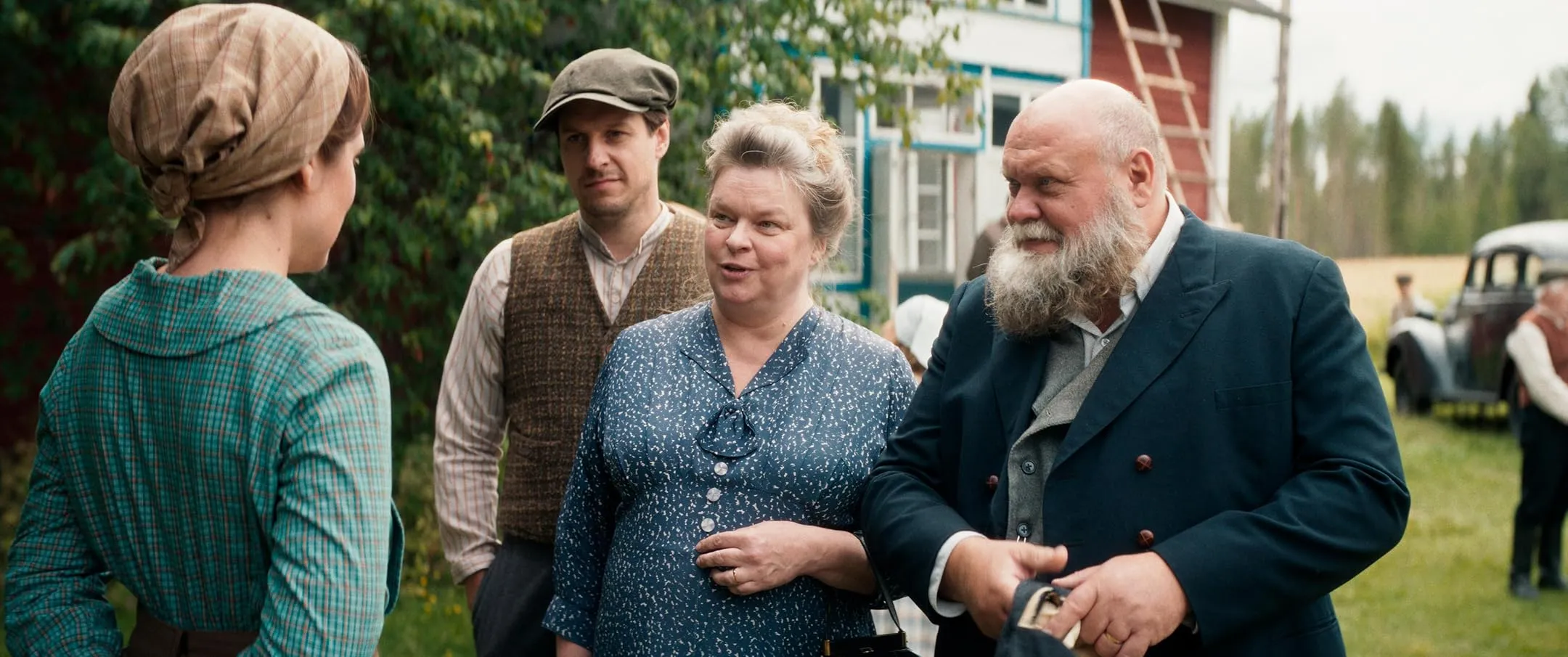Raptures emerges from the frosted desolation of 1930s northern Sweden, casting its somber light on a village where fervent rites merge with internal discord. In this landscape, severe and unyielding as the winter itself, the narrative unfolds amid a palpable tension between devout ritual and personal disquiet.
Rakel, a principled schoolteacher fluent in both her native tongue and Swedish, finds herself adrift amid an environment where everyday faith contorts into radical certitude. Her husband, Teodor, succumbs to mystic callings that unravel the very fabric of communal trust, his transformation casting a long shadow upon the hearts of those around him.
The film harnesses the stark northern environment as a mirror to the human condition—a place where isolation intensifies the stark interplay of internal strife and collective despair. The use of Meänkieli, a minority Finnic language, not only enriches the narrative with cultural layers but also deepens the sense of estrangement felt by each character. The austere scenery and its oppressive silence serve as both witness and arbiter to the unfolding personal crises and social disintegration, prompting one to reflect on the darker intersections of belief and human vulnerability.
Discordant Threads: The Unraveling of Faith and Order
In the remote Torne Valley of 1930s northern Sweden, a stoic village emerges—its everyday life marked by age-old customs and hierarchies borne from a history of isolation. Rakel, tasked with nurturing young minds as a schoolteacher, anchors a community steeped in tradition. Here, the solid structures of daily routines and communal bonds stand in stark relief against the harsh, unforgiving winter landscape.
Yet change arrives with a tremor. Teodor, once a respected pillar of the village, finds himself seized by an inner tumult that compels him toward a radical interpretation of faith. His slow descent from a benign figure into a fervid believer crafts a narrative marked by a growing dissonance. A visiting preacher, with an uncanny aura of otherworldliness, casts a provocative spell that tilts the balance, sparking the genesis of a secretive sect. This nascent collective, characterized by its unsettling rites and frayed moral fabric, begins to warp the intimate ties of familial love and communal duty.
As Teodor ventures deeper into a realm of extreme visions, each step in his transformation carries bitter consequences. Moments arise when Rakel, bound by duty and personal trepidation, confronts the weight of loyalty versus the stirrings of disquiet within her spirit. The narrative surges with episodes where the quiet veneer of a humble village shatters, revealing the raw, painful costs of a belief system unmoored from reason. The unfolding drama leaves one pondering whether the story’s current twists point toward closure or persist as an open question concerning faith and the human soul.
Shattered Masks and Veiled Truths
Rakel emerges as a figure in torment—her daily life as an educator and devoted spouse interrupted by an undercurrent of doubt and fear. Her existence within this harsh village mirrors the clash between gentleness and relentless winter, her inner world a quiet battleground where personal values and imposed loyalties collide.
In scenes marked by subdued gestures and transient expressions, the actress presents Rakel as a vessel of suppressed distress—a woman quietly wrestling with her roles, torn between preserving what she has built and sensing an impending rupture in her world.
Conversely, Teodor transitions from a pillar of the community into an individual claiming divine purpose. His transformation traces the contours of a moral decline. His presence on screen oscillates between a magnetism that once commanded respect and a stark severity that now hints at personal obsession and a disregard for the wellbeing of those around him. His portrayal unfolds in measured pulses—each word and subtle shift in demeanor suggesting a conviction that verges on tyranny.
Supporting performances add threads of complexity to this narrative fabric. The youthful step-daughter and other villagers appear as silent witnesses to the unraveling of cherished bonds, each interaction deepening the sense of a community caught in an inevitable spiral.
The film employs a careful use of multiple tongues, and the authenticity conveyed by such linguistic layers enriches the portrayals. The subtle interplay of muted dialogue and discreet expressions composes a portrait of human fragility and stark self-deception that continues to question the price one pays for relinquishing moral clarity.
Existential Veils: Faith, Identity, and the Flickering Mirage
Raptures offers a meditation on the corrosive effects of radical belief and the unseen costs of uncompromising power. The film presents religious obsession and toxic masculinity in stark relief; a once-respected figure is distorted by dangerous convictions that erode both family and community.
Rakel’s internal struggle becomes a mirror for this disquiet. As she strives to maintain the integrity of her roles as educator and partner, her inner life is troubled by ancient customs clashing with emerging ethical puzzles. Her quiet resistance speaks to the tragic price exacted when certainty is sacrificed at the altar of extreme faith.
Language, in this narrative, serves a dual function. Rakel’s command of two distinct tongues reflects the collision between Swedish and Finnish traditions—each syllable a marker of cultural allegiance and isolation. The shifting cadence of dialogue, rendered through a minority language, sharpens the divide between personal conviction and communal expectation, revealing fissures that undercut the surface of daily existence.
A recurring image in the film is that of a golden ark—an emblem of a promised salvation that never materializes, a false beacon glimmering in the bleak northern skies. This symbol, alongside stark vistas and ritualistic gatherings, functions as a constant reminder of fragile hope and the pervasive lure of transformation through radical thought. At moments of ritual and quiet introspection alike, the film raises questions about the nature of obedience and free agency, probing the tension between what is preached and what is lived.
The interplay between the visible descent into fanaticism and the more hidden commentary on societal isolation presents a subtle interrogation of power and surrender. Even set in a remote, historical landscape, these themes trace a line through the ages, echoing concerns over extremist impulses and the fragmentation of communities today.
Frozen Frames of Isolation and Memory
Raptures stages its narrative against a canvas of endless ice and muted light, where the snow-covered lands assume a role that transcends mere background and becomes an integral presence in the story’s melancholic heartbeat. The vast, unyielding expanse of the northern terrain radiates a chill that seeps into every frame, a silent witness to the internal confinement experienced within the village. Here, the broad wilderness and the enclosed community are set in opposition—a reminder that the grandeur of nature can amplify the isolation of human existence.
Every element of the film’s design harks back to the austere spirit of the 1930s. The painstaking recreation of period life, from timeworn costumes to rustic interiors, conjures an atmosphere steeped in a heritage of hardship and tenacity. This commitment to authenticity morphs the village into an almost mythic realm, where every weathered structure and threadbare fabric echoes unspoken stories of endurance.
The camera moves with deliberate intent. Wide-angle compositions reveal the overwhelming isolation of the snowy landscape, while tighter shots confine characters within spaces heavy with unexpressed emotion. A distinctive technique is the use of color-coded subtitled dialogue; each hue marks a linguistic nuance, serving as a quiet allegory for cultural division and inner fragmentation. The interplay of light and shadow—captured through measured camera movements—creates visual murmurs of public composure veiling private desolation, inviting reflection on the quiet toll exacted by hidden truths.
Whispers in the Dark: Sound and Vision Unbound
The film’s auditory world emerges as a canvas of disquiet, where the harmonium and woodwinds paint moods of shadow and unrest. A low, resonant hum weaves through the scenes, echoing a quiet warning of inner dissolution, even as subtle shifts in tone carry a weight that mirrors the characters’ trembling hearts. The soundtrack functions as a spectral narrator, its gentle murmurs giving way to sharper, dissonant notes that suggest both the fragility and ferocity of belief.
A director’s hand, measured yet restless, captures fleeting moments of muted despair alongside bursts of religious fervor that stagger like dying embers in a cold wind. Here, precise techniques in framing and lighting foster a tension that is felt rather than merely seen. Transitions and montage sequences become the quiet arbiters of fate, methodically revealing the slow unfurling of a dangerous creed while evoking sensations akin to an unseen storm gathering over a desolate plain.
The film’s pace mirrors the internal cadence of souls caught in a relentless struggle between duty and doubt, a rhythm that is alternately languid and charged with an almost imperceptible urgency. In scenes where visuals and sound commune in secret, the uneasy symphony of images and echoes crafts a subtle inquiry into the peril of unseeing adherence. This sensitive orchestration of sight and sound summons questions about the power of faith that demands total surrender, leaving a lingering murmur in the spaces between light and darkness.
Echoes of the Past: Culture, Language, and Unyielding Divides
The narrative unfurls against a backdrop shaped by the enigmatic whispers of the Korpela Movement—a sect born from a radical reimagining of Lutheran dogma amid the turbulence of early twentieth-century schisms. Within this historical matrix, the film finds its pulse in the murmur of aged traditions clashing with the emergence of divergent belief systems, hinting at how faith’s visage can be reshaped in desperate moments of change.
The film’s deliberate embrace of Meänkieli—a language steeped in the legacy of the Torne Valley—functions as an evocative emblem of cultural authenticity. This minority tongue, rarely heard in cinematic discourse, becomes a resonant marker of heritage and resistance. As dialogue flows alternately in Meänkieli, Swedish, and Finnish, the interplay of sounds and meanings constructs a mosaic of identities, each accentuating the isolation or unity of its speakers in this secluded world.
In depicting the impact of stringent language policies and generational segregation, the film portrays a community burdened by its own legacy—a people set apart by linguistic pride and the silent assertion of long-held customs. Here, internal divisions simmer beneath a surface of habitual obedience, with some clinging fervently to established norms while others hint at the allure of external modernity. These historical and linguistic tensions shimmer with echoes of today’s struggles over cultural preservation and ideological rigidity, provoking questions about the permanence of identity amid relentless change.
Full Credits
Director: Jon Blåhed
Writers: Bengt Pohjanen (book), Jon Blåhed (screenplay)
Producers: Tiina Pesonen, Tony Österholm, Andreas Emanuelsson
Cast: Jessica Grabowsky, Jakob Öhrman, Rebekka Baer, Hannu-Pekka Björkman, Elina Knihtilä, Alma Pöysti, Hannes Suominen, Anton Raukola
Director of Photography (Cinematographer): Mimmo Hildén
Composer: Rebekka Karijord
The Review
Raptures
Raptures endures as a stark investigation into the cost of unexamined belief, interlacing the somber rigors of history with a visceral aesthetic of isolation. Its narrative and visual landscapes prompt a reflective melancholy, probing the depths of human vulnerability under ideological extremism. The film stands as a haunting reminder of our propensity for self-deception and the quiet disintegration of community bonds.
PROS
- Striking visual design and detailed period accuracy
- Powerful performances that capture inner turmoil
- A thought-provoking exploration of deep, existential themes
- Authentic use of language enhancing cultural context
- A haunting, atmospheric score that reinforces the mood
CONS
- Uneven pacing in moments of narrative transition
- Some dialogue may feel overly formal
- Certain character motivations remain opaque
- A tendency toward understated emotional expression





















































